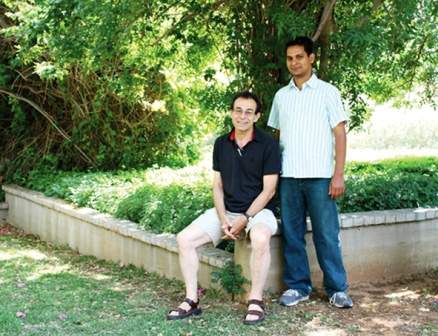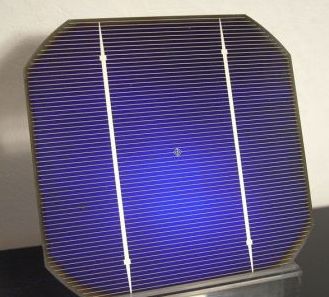
“One of my dreams for the field of alternative energy is to see the day when all homes will be covered in ‘solar paint’,” says
Prof. David Cahen of the Weizmann Institute’s Materials and Interfaces Department (Faculty of Chemistry).
“The trick,” says Cahen, “is to understand the limitations, as well as the capabilities, of each type of solar cell and then find a suitable niche for its use.” Current solar cell technologies are relatively expensive – unable to convert the sun’s energy into electricity with cost-effective efficiency. Although the solar energy that reaches Earth in just one hour equals the entire energy needs of the world for a whole year, calculations show that even the best solar cell can never reach an efficiency of more than about 31% – and this figure is lower in practice. Simple economics shows that solar cells with low efficiency are worthwhile only if they are also cheap.
Half a century ago, William Shockley and Hans Queisser identified three factors limiting the efficiency of the commonly used “sandwich-layered” solar cell: 1) It has a limited spectrum of light absorption; 2) much of the absorbed light energy is lost as heat; and 3) electric current is lost in the cell before it can be used. Newer generations of solar cells have been constructed from organic, molecular and polymeric materials, but even in optimal lab conditions, their performance is lower than that of most of today’s commercial solar cells. Are there other factors, beyond the SQ limits (named for their proposers), that need to be taken into account?
To find out, Cahen and postdoctoral fellow Dr. Pabitra Nayak (a graduate of the Tata Institute of Fundamental Research, India), with the help of Prof. Juan Bisquert of Universitat Jaume I, Spain, analyzed and compared various criteria of all the different types of solar cells. Their findings, recently published in
Advanced Materials suggest that there are indeed
additional limiting factors beyond the SQ limits – at least for solar cells made with organic materials – that can explain the extra energy loss.
A “typical” solar cell is made from two layers of inorganic semiconducting material – most commonly, crystalline silicon. One of the layers is electron-rich, the other electron-deficient. Stacking these two layers creates a region with an electric field. When light strikes the semiconductor, freeing electrons from their bonds, electricity is generated. The electric field acts as a one-way gate, allowing the “free” electrons to travel through a wire connecting the two layers, thus creating an electric current.
The three SQ limits come into play as the light strikes the material. The “limited spectrum of light absorption” means that some of the light does not possess enough energy to free electrons in any given material and passes through the cell unused. If, on the other hand, the light has more energy than the amount needed to free electrons, the extra energy is lost as heat – limiting factor number two. The third limiting factor involves freed electrons that return to their bound states before they can escape through the wire.

But materials made of organic molecules have an entirely different structure than the non-molecular, inorganic materials currently used for solar cells, and this, according to Cahen, may contain clues to their lower efficiency values. For example, organic materials are more disordered – a state that requires more energy to free electrons and create a current. Some energy is also lost in the form of bond vibration as an electron is freed in the interaction of light with organic materials. Weaker bonding between organic molecules also leads to reduced electron movement through the semiconductor layer, and this causes some of the freed electrons to lose energy. These latter two phenomena occur in all solar cells, but they are small to negligible in the classic, inorganic cells.
Should researchers give up on organic-molecule-based solar cells? Or should they continue seeking ways to improve their efficiency? That, says Cahen, might be akin to pushing dyslexic students to excel in literature: “Instead of investing time and effort trying to reach unrealistic efficiencies, knowing their limitations up front leads to more reasonable expectations of what the cell can do, and it can therefore be put to a more suitable use. For example, molecular-type cells could be perfect for use in solar paints despite their lower efficiency, and they can be much cheaper to produce than silicon-based solar cells, which are not even an option for such applications. Organic molecules also may be well suited for exploiting specific parts of the solar spectrum.”
Additionally, Cahen views his research as very relevant for artificial photosynthetic systems – in which solar energy is converted to chemicals. “Solar cells are like a beta site for learning about artificial photosynthesis. If we can realize both artificial photosynthesis and solar paint, we will have added some very significant pieces to the mosaic that will make up our energy future.”
Prof. David Cahen's research is supported by the Mary and Tom Beck Canadian Center for Alternative Energy Research, which he heads; the Nancy and Stephen Grand Research Center for Sensors and Security; the Helen and Milton A. Kimmelman Center for Biomolecular Structure and Assembly; the Gerhardt M.J. Schmidt Minerva Center on Supramolecular Architectures, which he heads; the Carolito Stiftung; the Wolfson Family Charitable Trust; Dr. Monroe Burk, Columbia, MD; the estate of Theodore E. Rifkin; the Jacob and Charlotte Lehrman Foundation; and the Irving and Varda Rabin Foundation of the Jewish Community Foundation. Prof. Cahen is the incumbent of the Rowland and Sylvia Schaefer Professorial Chair in Energy Research.

